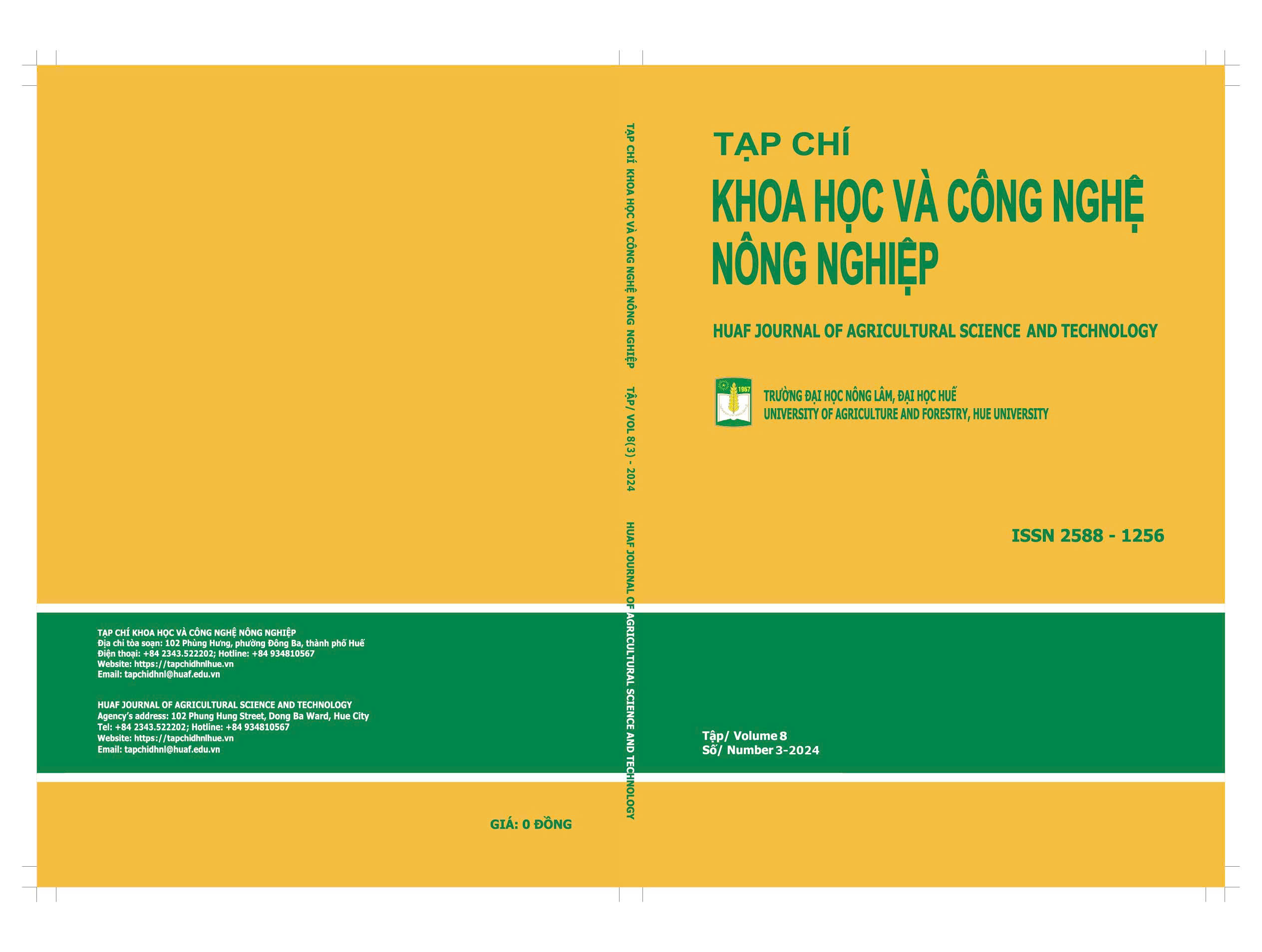##plugins.themes.huaf_theme.article.main##
Abstract
In Ben Tre, coconut (Cocos nucifera L.) is a main industrial crop with the largest growing area in Vietnam and are increasing day by day. In recent years, coconut production has been affected by saline intrusion. This study was conducted to evaluate the situation of coconut cultivation under salinity conditions via interviewing households in five districts including Chau Thanh, Giong Trom, Ba Tri, Thanh Phu, and Binh Dai, Ben Tre province, Vietnam. The results showed that during the dry season, salt water intruded into 100% of coconut gardens surveyed in Giong Trom, Ba Tri, Thanh Phu, Binh Dai districts, but 0% of coconut gardens in Chau Thanh district suffered from salt intrusion. Farmers apply farming techniques such as watering (33.3 to 96.7%), applying mud to coconut trees (over 76.6%), and weeding coconut gardens (over 80%). There are 10.0 to 70.0% of households applying inorganic fertilizer during the basic construction period and 13.3 to 93.3% applying during the business period; Fertilization frequency is from 4 to 6 times per year. There are 10.0 to 70.0% and 50.0 to 96.7% of households applying organic fertilizer during the initial period and harvested period, respectively; Fertilization frequency is 3 to 4 times per year. It is necessary to evaluate the influence of water salinity and farming techniques on the growth and development of coconut trees in order to complete a reasonable technical process of coconut production, contributing to the sustainable development of coconut trees in Ben Tre province.
##plugins.themes.huaf_theme.article.details##
References
Nguyễn Văn Đào và Phạm Thị Thanh Bình. (2019). Đánh giá thực trạng và tác động của biến đổi khí hậu đến xâm nhập mặn tỉnh Bến Tre. Tạp chí Khí tượng Thuỷ văn, 04(2019), 12-22.
Trần Văn Hâu và Nguyễn Chí Linh. (2011). Khảo sát đặc tính ra hoa của một số giống dừa (Cocos nucifera L.) cao được trồng tại huyện Giồng Trôm, tỉnh Bến Tre. Tạp chí Khoa học Trường Đại học Cần Thơ, 17(a), 210-218.
Trần Tiến Khai, Lê Văn Gia Nhỏ và Nguyễn Văn An. (2012). Đánh giá hiệu quả sản xuất dừa ở nông hộ tỉnh Bến Tre. Tạp chí Phát triển Nông nghiệp và Nông thôn Việt Nam, 262, 21-25.
Tất Anh Thư, Võ Hoài Chân và Võ Thị Gương. (2013). Một số đặc tính đất vườn trồng ca cao xen trong vườn dừa tại huyện Châu Thành, tỉnh Bến Tre. Tạp chí Khoa học Trường Đại học Cần Thơ, 25, 260-270.
Thái Nguyễn Quỳnh Thư, Lưu Quốc Thắng, Phạm Phú Thịnh, Nguyễn Thị Mai Phương, Nguyễn Đoàn Hữu Trí và Nguyễn Thị Bích Hồng. (2020). Ảnh hưởng của liều lượng phân bón đến sinh trưởng, phát triển và năng suất của dừa trong điệu kiện xâm nhập mặn vùng đồng bằng sông Cửu Long. Tạp chí Công Thương: Khoa học công nghệ, 41(4), 38-40.
Nguyễn Đoàn Hữu Trí, Lê Công Nông, Thái Nguyễn Quỳnh Thư, Lưu Quốc Thắng và Nguyễn Đức Xuân Chương. (2020). Ảnh hưởng của phân lân đến sinh trưởng, năng suất và chất lượng dừa ở đầu giai đoạn kinh doanh trong điều kiện xâm nhập mặn tại đồng bằng sông Cửu Long. Tạp chí Nông nghiệp và Phát triển, 19(4), 18-27.
Nguyễn Thị Thanh Trúc và Trương Văn Tuấn. (2016). Ảnh hưởng của phát triển ngành dừa đến môi trường tự nhiên ở tỉnh Bến Tre: Hiện trạng và giải pháp. Tạp chí Khoa học Trường Đại học Sư phạm Thành phố Hồ Chí Minh, 6(84), 177-187.
Nguyễn Bảo Vệ, Trần Văn Hâu và Lê Thanh Phong. (2005). Giáo trình Cây Đa Niên, Phần II cây công nghiệp. Cần Thơ: Trường Đại học Cần Thơ.
Baloch, P. A., Moizuddin, M., Imam, M., Abro, B. A., Lund, J.A., & Solangi, A. H. (2004). Effect of NPK fertilizers and farmyard manure on nut production of coconut (Cocos nucifera L.). Asian Journal of Plant Sciences, 3(1), 91-93.
Cheng-Xu, S., Hong xing, C., Hong bo, S., Xin tao, L., & Yong, X., (2011). Growth and physiological response to water and nutrient stress in oil palm. African Journal of Biotechnology, 10(51),10465-10471.
Diep, H. T. M. (1994). Influence des contraintes edaphiques sur la nutrition minerale, le developpement et la production du cocotier (Cocos nucifera L.) dans des sols sulfates acides sales ou non sales de delta Mekong: Effet ameliorant d’un apport de phosphate naturel. Du titre de Docteur De L’Uinversite Paris XII, Universite Paris Val De Marne.
Food and Agriculture Organization of the United Nations. (2024). Retrieved February 10, 2024, from http://www.fao.org/faostat/en/#data/QC.
Kushwah, B. L., Nelliat, E. V., Markose, V. T., & Sunny A. F., 1973. Rooting pattern of coconut. Indian Journal Agronomy, 18, 71-74.
Loganathan, P., & Balakrishnamurti, T. (1980). Effects of NPK Fertilizers on young Coconut (Cocos nucifera) on a Sandy Soil in Sri Lanka. Experimental Agriculture, 16(1), 41-48.
Prema, D., Jose, A. I., & Nambiar, P. K. N. (1987). Effect of sodium chloride on growth and yield of coconut palms in a laterite soil. Agricultural Research Journal of Kerala, 25(1), 66-73.
Stephanie, E. (2003). Slovin’s Formula for Sampling Technique. New York: Houghton-Mifflin.

